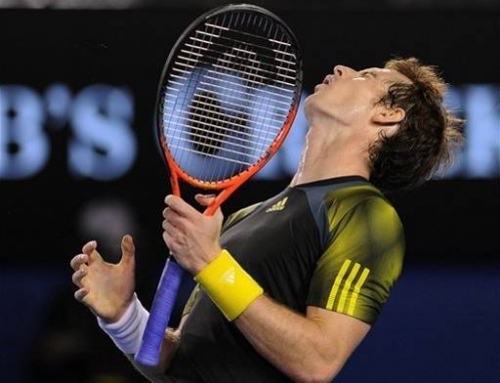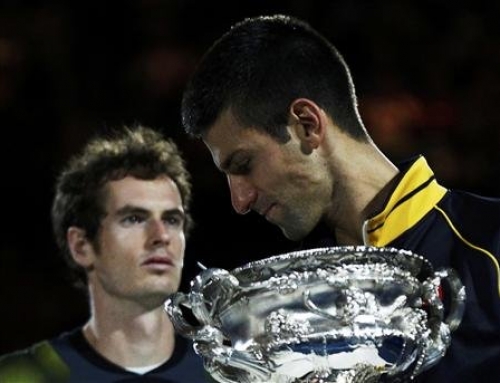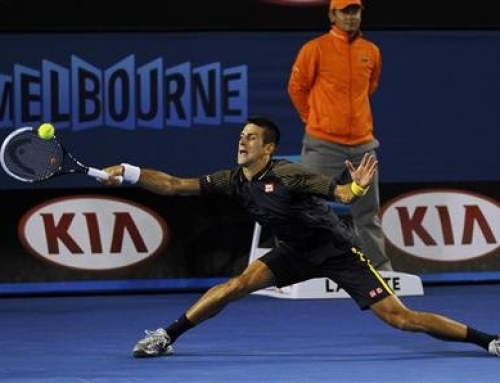Jo-Wilfried Tsonga had never played Nicolas Almagro. It almost didn’t seem like a fair fight. Almagro, after all, had a broken wrist. But fortunately, it was his left wrist that was broken, and he’s a righty with a one-handed backhand. Almagro’s known for his big serve and power hitting, but Tsonga is the flash Frenchman.
Tsonga took the first two sets 6-3, 6-4. But Almagro came back and took the next two sets 6-4, 7-6(5). This lead to Tsonga’s first five setter ever, a surprising stat given how long he’s played. The two played an epic fifth set that eventually went to the Frenchman, 9-7.
There’s something about beating a guy 14 times in a row that gives Roger Federer confidence. They say players like Verdasco and Gonzalez are rhythm players. When they play well, they feel they can’t miss. However, their rhythms can also be disrupted. Verdasco just makes a ton of errors regardless of who he plays, but he often hits a winner before he makes an error. Against a Davydenko, Verdasco often has to hit more shots than he wants to because Davydenko can deal with power. Gonzalez can also go through periods where his backhand is being attacked and he goes off some.
Federer resembles these players except at the highest levels. When he plays those he has beaten a lot, which includes Lleyton Hewitt and Andy Roddick, he has incredible confidence. Shots he misses against lesser players he doesn’t miss against these guys. Federer used to be in some awe of Hewitt. Hewitt was a fast mover and could attack his backhand. Federer credits Hewitt, more than Nadal, for making him the player he is today, forcing him to address his groundstroke deficiencies.
Federer uses a variety of familiar tactics against Hewitt, including his slice backhand which either tempts Hewitt to come in where Fed makes the pass, or Hewitt slices the slice back, and Federer runs around the crosscourt and powers the inside-in shot. And of course, Federer serves well, so he tends to win his serve anyway. The one thing Hewitt has is his competitiveness, but he lacks the killer shot, playing his game more like his hero, Mats Wilander, a game of moving the ball around and perhaps opening a good shot, but not the kind of power game that lets him hit winners from whereever.
This is the kind of ideal match for Federer because he has such great confidence against Hewitt that those shanks, those nervous shots, those what-was-that mistakes disappear. Federer wins easily, 6-2, 6-3, 6-4, even though Hewitt was starting to bother Federer, with a late break to get on serve, but then got broken back again. With Fed trying to serve out the set, Hewitt again had chances to break, but Fed played tough and completed the task.
Tomorrow, Roddick plays Cilic in the last of three matches on Rod Laver Arena. The two are 1-1. Roddick last played Cilic in Toronto in 2008 and lost in 3 sets. Roddick would point out that that summer was a blow to his confidence. Expecting to have a great summer leading to the US Open, Roddick entered the US Open unsure of his game having lost matches he had hoped to win, including this loss to Cilic. Even at higher confidence, Cilic is a man on the rise. Roddick says his strategy is much like it is with Gonzalez. He needs to weather the storm, i.e., hold his serves, and hope to break serve here and there. Cilic moves quite well for a big guy and is pretty steady too, so this will be a tall order for Roddick. Roddick is better against less steady players where his own steadiness can come into play.
And in the evening match, the match everyone has been waiting for: Andy Murray vs. Rafael Nadal. Nadal owns the head-to-head with a 7-2 lead. This match is a consequence of Murray deciding not to play Doha therefore failing to defend points. He fell 5 points behind Juan Martin del Potro and slipped to 5th. But because del Potro failed to defend his points in Auckland, Murray was back to number 4 at the start of the tournament, even though it was too late to affect his draw.
The last time Murray met Nadal in a quarterfinal at a Slam was the US Open in 2008, which was a breakout match for Murray. Murray was able to dictate the play against Nadal. Meanwhile, Nadal was at the point in the year where he normally struggles. Historically, Nadal plays worse in the second half of the year, after the clay court season and the grass court season has taken its toll. It’s the one Slam he’s never reached the final, although he’s reached the semifinals twice.
Murray will probably have this match in mind as he plays Nadal. This is a tricky match to call. Murray has yet to drop a set, while Nadal has dropped two sets. In the last 3 matches, Murray has won one match (in Rotterdam), and Nadal the next two (Indian Wells and Monte Carlo). Each match had its story. In Rotterdam, Nadal had been injured and yet continued to fight despite losing pace on his serve. Murray took the third set 6-0 although Nadal was noticeably hobbling (turned out to be a temporary injury, as he was fine for the next tournament).
Indian Wells was an odd match too. Played in a near windstorm, Nadal simply handled the breezy conditions a lot better than Murray, so although it was lopsided to Nadal, 6-1, 6-2, Murray likely discounts this final as a freak of weather which Nadal just managed a lot better. And finally, the match in Monte Carlo was on clay, which is Murray’s worst surface and Nadal’s best surface. The match prior to this was Murray’s breakthrough US Open match.
In other words, other than the win-loss record, the last 3 matches don’t say much about how this match will go. On the one hand, Murray is playing quite well, for his style of play. He is moving as well as he ever has, but his serve seems to be off a bit. On the other hand, Nadal isn’t playing or moving at top form, yet, he’s not playing badly either. He’s sharper than he was at the end of 2009, yet not as sharp as he was in 2008. Is that enough of a difference for Murray to beat Nadal?
Recall that Nadal has not won a tournament since Rome and has only beaten two top 10 player since then–Jo-Wilfried Tsonga in the quarterfinals of Paris and Novak Djokovic in the semifinals of Madrid. Since then, he’s lost to Federer in the finals of Madrid, lost to del Potro in Montreal, to Djokovic in Cincinnati, to del Potro again at the US Open, to Davydenko in Shanghai, to Djokovic again in Paris, and to Soderling, Davydenko, and Djokovic in the round robin of the ATP Tour Finals. In 2010, he lost to Davydenko yet again in the semifinals of Doha.
So his losses have been to: Federer, Djokovic, Davydenko, del Potro, and Soderling. He didn’t play Murray during this stretch.
Darren Cahill predicted the upset for Murray. Brad Gilbert predicted Nadal would win, but felt if Murray could get through, his chances of winning the Australian would be pretty good, i.e., Nadal was his biggest challenge.
So we’re headed to the big matches tomorrow. Find out who reaches the semifinals of the AO!






![[Aussie Open Final] Can Andy Murray beat Novak Djokovic?](https://www.essentialtennis.com/wp-content/uploads/2013/01/20130126andy-500x383.jpg)
![[Day 13, Aussie Open] Bryan brothers win 13th Slam with Aussie doubles title, Kyrgios wins boys title](https://www.essentialtennis.com/wp-content/uploads/2013/01/20130125bryan-500x383.jpg)